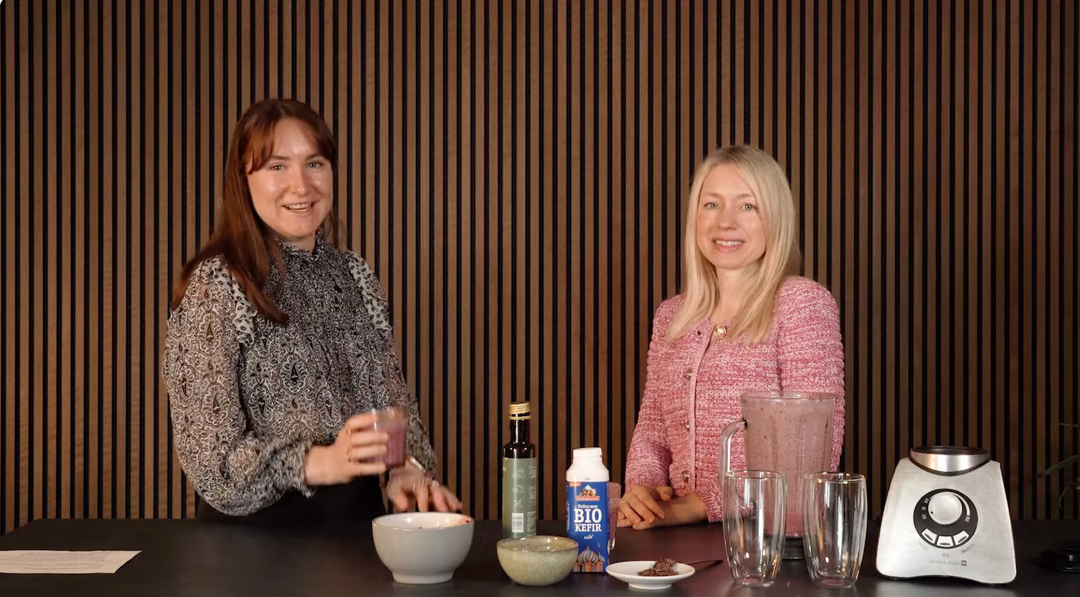Themen dieses Blogartikels:
Knowledge for your ears!
No time to read? Here you can listen to Claire's article.
Table of contents
- Sugar - a sweet problem?
- What was sugar again?
- Sugar alternatives – what are they and what’s behind them
- Sweeteners - Zero calories, many questions
- Sugar alcohols: xylitol & erythritol
- Fructose in the form of agave syrup and fruit syrups
- Fructose in food
- Natural sweetness: honey, maple syrup & coconut blossom sugar
- Honey, the good alternative, right?
- maple syrup
- Coconut blossom sugar or coconut blossom syrup
- Sweet herb Stevia
- Sugar alternatives conditional enjoyment
- Functional sugars
- Tagatose
- Galactose - the brain sugar
- Combination of tagatose & galactose
- Sugar types in comparison (brief overview)
- Sugar: Right amount & right sweeteners
Sugar alternatives - sweet without a guilty conscience?
Awareness of healthy eating has been changing for some time now. A healthy and conscious lifestyle is now considered desirable by many. When it comes to sugar in particular, “healthy” alternatives are now increasingly being offered or processed by the food industry. Are these substitutes or alternatives really better, or are they even more harmful than the usual granulated sugar?
Let’s rewind a bit – what was sugar again?
Let's briefly recap from Part 1 : Not all sugars are created equal – they belong to the large group of carbohydrates and can occur in various forms. The most common are glucose , fructose , lactose , and sucrose (table sugar). Chemically, they all consist of carbon, hydrogen, and oxygen, but differ in their structure and effect in the body.
A distinction is made between:
- Simple sugars (monosaccharides) such as glucose or fructose,
- Disaccharides such as sucrose or lactose,
- as well as complex and polysaccharides found in cereals, legumes or vegetables.
The shorter the chain, the sweeter the taste – and the faster the sugar works in the body.
Sugar alternatives - what are there & what's behind them
Sweeteners - zero calories, many questions
Eleven artificial sweeteners are currently approved in the EU. The most well-known are: saccharin, cyclamate, saccharin-cyclamate mixtures, aspartame, acesulfame, neohesperidin DC, and thaumatin . They have no glycemic index and therefore do not affect our blood sugar levels. However, a study conducted in India demonstrated that insulin is still secreted by the pancreas . When we taste sweetness, our body expects glucose. If this is not the case, the hypothalamus sends the "hunger" signal 1. Another study shows that sweeteners can have a negative effect on our intestinal flora2.
You should pay attention to the maximum intake of sweeteners set by the WHO, as exceeding these limits can cause severe symptoms3.
Sugar alcohols: xylitol & erythritol
The best-known sugar alcohol is probably birch sugar (xylitol), which was originally made from birch bark. Xylitol is now extracted from agricultural raw materials such as corn, wood, or straw. It protects teeth and has been proven to fight caries-causing bacteria. It is just as sweet as table sugar, but has 40% fewer calories and barely affects blood sugar levels. However, xylitol influences our gut microbiome. It can cause changes in bacterial strains. This can be beneficial if these strains overgrow, but it can also be detrimental4.
Erythritol is derived from starch. It has no calories because it is absorbed through the small intestine and 90% is excreted in the urine. This greatly reduces side effects such as bloating and diarrhea. For people who experience intestinal problems when taking erythritol, its prebiotic effect is likely at work. Like xylitol, erythritol influences the growth of some bacterial strains and can also slightly increase the production of butyrate (an important product for intestinal health).5
Fructose in the form of agave syrup and fruit syrups
Fructose is a type of simple sugar found in many natural foods. It is often used in cooking as a sugar substitute to sweeten foods and beverages while reducing the sugar content.
Agave syrup has a low glycemic index and is even sweeter than table sugar, but has fewer calories than table sugar. This is due to its high fructose content, also known as fruit sugar. Our bodies can only break down fructose in the liver . If we consume too much , the liver becomes overloaded and stores the fructose. In the long term, this can lead to fatty liver disease or even liver cirrhosis6.
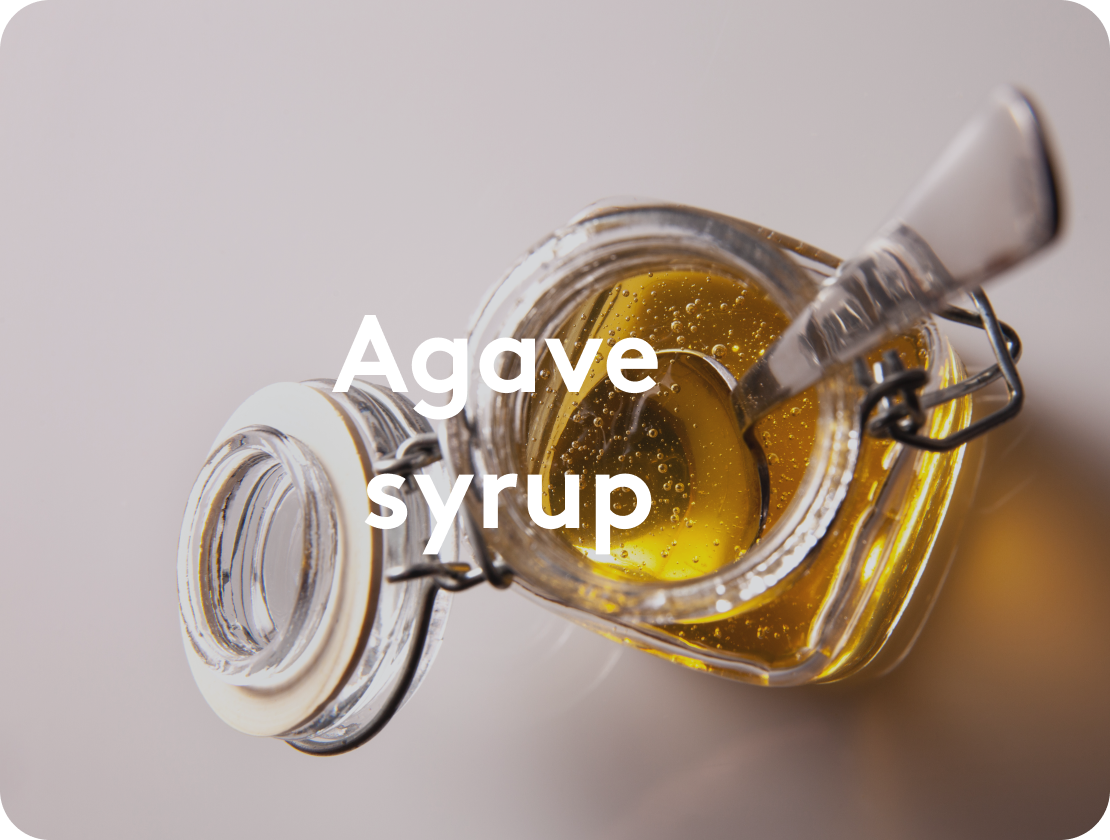

In addition, excessive fructose consumption can disrupt metabolism, increase the risk of cardiovascular disease, and promote insulin resistance.7 Too much fructose can lead to digestive problems. If you are allergic to fructose, you should avoid these sweeteners. Be careful of the amount of fructose you consume. Humans can metabolize approximately 25-80 grams of fructose per day.
Fructose in food
Fructose (fruit sugar) occurs naturally in many fruits and some vegetables. The following foods contain particularly high amounts:
- Dried fruits such as dates, raisins and figs
- Fruit juices and smoothies , especially from grapes, apples or pears
- Honey
- Agave syrup (extremely high fructose content)6.
- Soft drinks and convenience foods , often with added fructose or high fructose corn syrup (HFCS)
Even seemingly healthy snacks like “fitness bars” or cookies can often contain hidden fructose – a closer look at the list of ingredients will often give you more information.
Watermelon also contains fructose, but in moderate amounts. About 6–7 g of sugar are contained per 100 g of watermelon, and fructose makes up a large portion of this. Since watermelon is about 90% water, the overall sugar content is relatively low, making it a refreshing and low-calorie fruit.
Natural sweetness: honey, maple syrup & coconut blossom sugar
Honey, the good alternative, right?
Honey is probably the oldest sweetener and was already called the food of the gods in ancient Egypt. Honey contains minerals and vitamins, and has always been used for its anti-inflammatory and wound-healing properties.
Nevertheless, honey consists of 80% glucose and fructose, so you have to pay attention to the recommended daily amount. Honey should not be heated, so that the valuable ingredients are preserved.
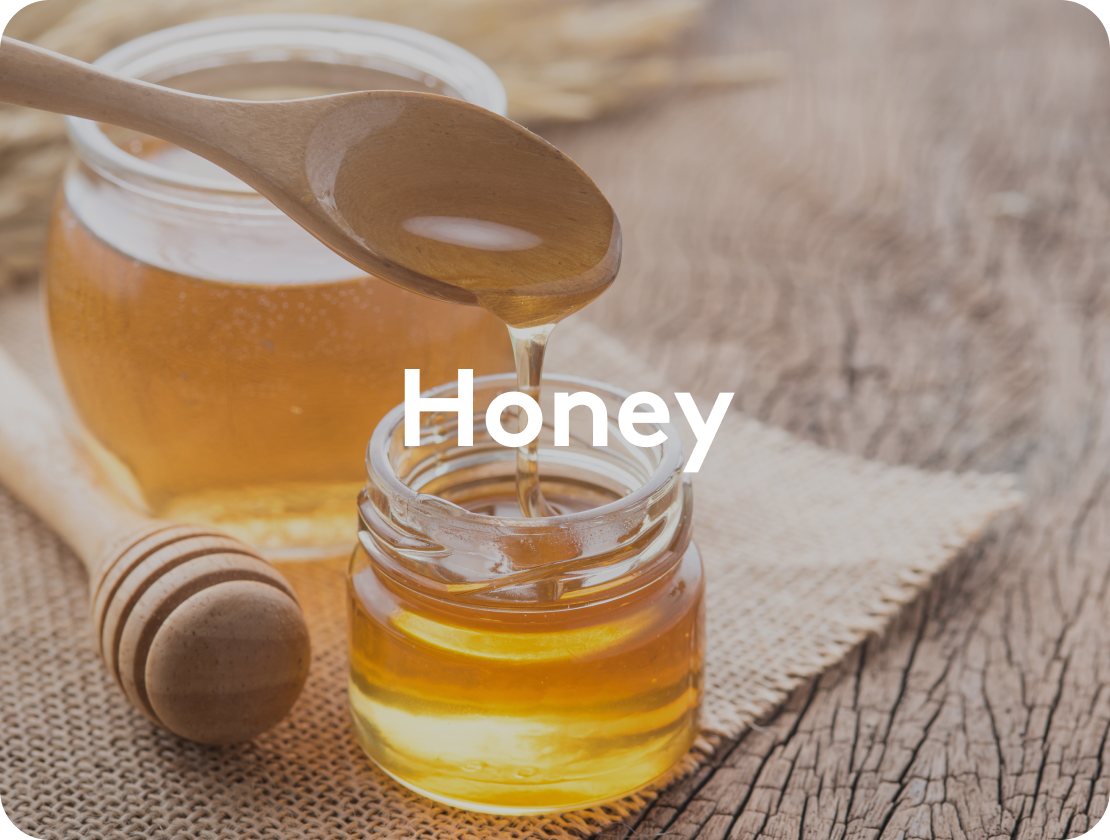

Glycin, die süßliche Aminosäure
Glycin – eine Aminosäure, die nicht nur vielfältige physiologische Aufgaben erfüllt, sondern auch eine überraschende Süßkraft besitzt. Glycin ist die einfachste Aminosäure im menschlichen Stoffwechsel – klein, aber vielseitig. Unser Körper produziert sie selbst aus L-Serin, nimmt sie aber auch über die Nahrung auf, insbesondere durch gelatine- und kollagenreiche Lebensmittel. (Holeček, 2025). Insgesamt werden täglich bis zu 60 g Glycin umgesetzt – bis zu 80 % davon stammen aus der körpereigenen Synthese.¹⁵
Glycin hat einen natürlich süßen Geschmack – etwa 60–70 % der Süßkraft von Haushaltszucker – und eignet sich deshalb auch als Zuckerersatz. Interessant ist: Seine Süße kommt ohne kalorische Belastung durch Kohlenhydrate und ohne insulinogene Wirkung. Im Gegensatz zu Glukose beeinflusst Glycin den Blutzuckerspiegel nicht negativ – einige Studien deuten sogar auf eine insulinsensitivitätsfördernde Wirkung hin.¹⁶


Coconut blossom sugar or coconut blossom syrup
Coconut blossom sugar consists almost exclusively of sucrose and has just as many calories. However, it also contains vitamins, minerals and the fiber inulin. The glycemic index is 35, so it hardly raises blood sugar levels. Coconut blossom sugar is a sustainable alternative, but also the most expensive. Here it is also necessary that you pay attention to the amount consumed.
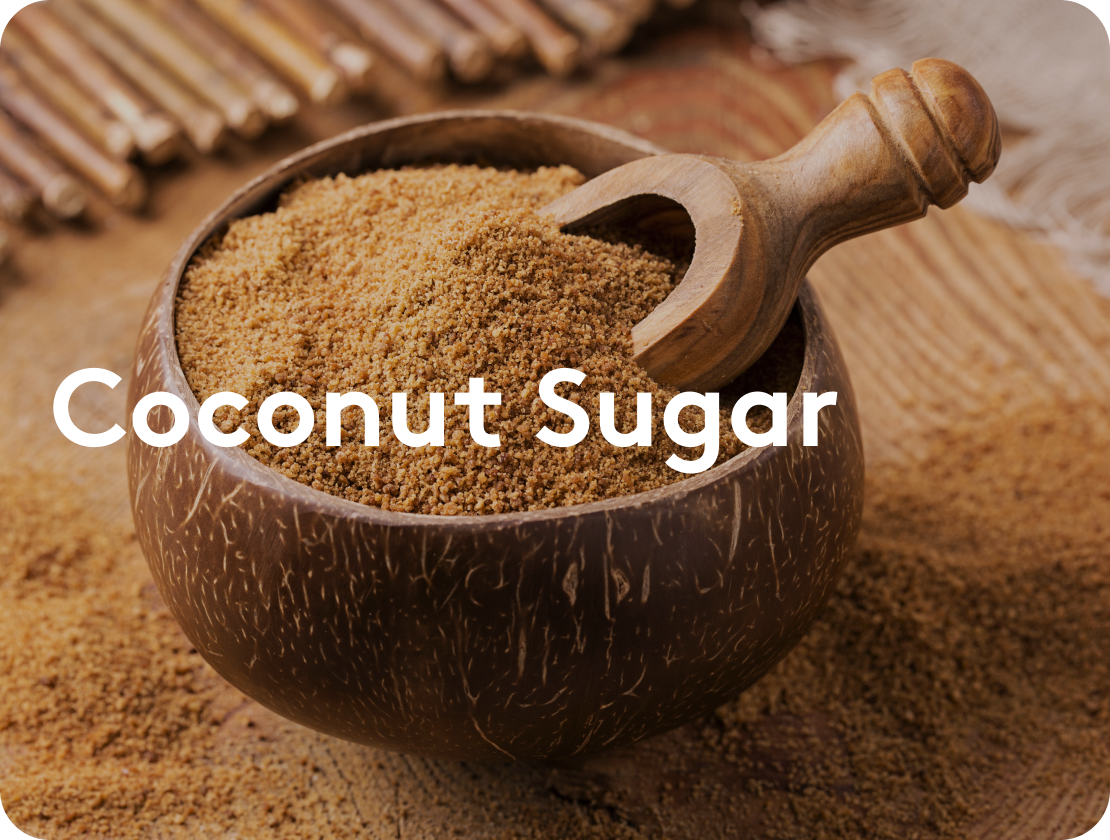

maple syrup
The syrup, which comes from Canada, consists of 60% sugar and is therefore less sweet. It has a typical caramel-like aroma and contains vitamins, minerals, antioxidants and anti-inflammatory substances. The glycemic index is 55. With maple syrup should be paid attention to the quality and ingredients, because this is often stretched with sugar water in low quality. Again, pay attention to the quantity so you don't exceed the recommended daily allowance of sugar. Also, like honey, it should not be heated.


Sweet herb Stevia
Stevia, also known as honey herb, contains no calories or sugar. It therefore does not raise blood sugar levels and is suitable for diabetics. The stevioside contained in stevia is 300 times sweeter than sugar. The dried herb is a natural product and has a licorice-like, bitter aftertaste. Steviosides are used in the food industry. These are chemically extracted components of the stevia plant. This extract can no longer really be described as natural. Stevia has been approved in the EU under the number E960 and the maximum daily amount is set at 4 milligrams per kilogram of body weight.
Sugar alternatives conditional enjoyment
Even with these sugar alternatives, enjoyment without a guilty conscience is only possible to a limited extent.
As you can see from the descriptions of the individual sugar alternatives, these also have some disadvantages that you should be aware of. Most of them still contain fructose, glucose, and sucrose, so you need to pay attention to the recommended daily intake – just like with sugar.
Some alternatives should not be heated, such as honey and maple syrup . Some can cause digestive problems, such as fructose, sugar alcohols, and some sweeteners. For some sweeteners, you should pay attention to the maximum recommended intake. Furthermore, sweeteners and steviol glycosides are not natural products; they are chemically produced or heavily processed.
Below you will find two promising sugar alternatives with benefits for your health.
What are functional sugars - why are they promising?
Tagatose
Tagatose is a natural monosaccharide structurally similar to fructose, but has one major advantage: It has a much lower absorption rate. Only 20% of ingested tagatose is absorbed in the small intestine and subsequently metabolized via the same metabolic pathways as fructose. The remaining 80% reaches the large intestine, where it is utilized and fermented by intestinal bacteria. 8. This fermentation leads to a greatly increased formation of butyrate. 9 This fatty acid promotes intestinal health and also influences metabolism. 10
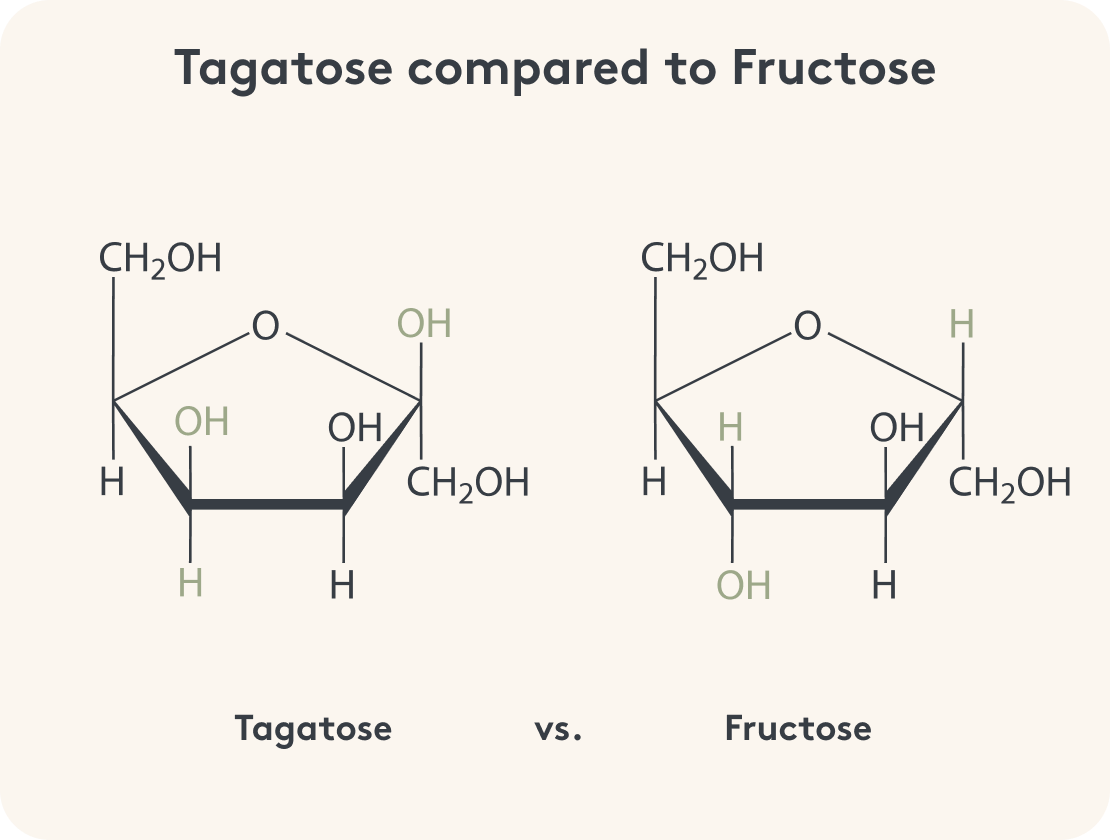

Tagatose is tooth-friendly according to studies in Zurich and is not metabolized by caries-causing bacteria.¹¹ Tagatose has a sweetening power of 92%, the glycemic index is 7.5 due to the low intake.¹²
Galactose - the brain sugar
Galactose is also called mucus sugar because it is bound to a protein (glycoprotein) and occurs in the mucous membranes of the nose, mouth and stomach. Galactose is utilized independently of the hormone insulin. It is a very valuable source of energy for our brain and supports our memory performance independently of insulin. In contrast to glucose, galactose is only metabolized by the mitochondria, so it fires up aerobic combustion, which provides significantly more energy. Especially in cells with perturbations in this area, galactose may therefore enhance mitochondrial utilization[13]. It is also an essential component of glycoproteins and glycolipids - which our bodies need for neuronal growth and function. Galactose is a natural sugar, it is found mainly as a building block in dairy products (lactose = galactose + glucose) and in plants with multiple sugars (legumes, sugar beets). Free galactose is found almost exclusively in fermented foods.
Another advantage of galactose, besides providing energy, is its tooth-protecting effect. According to one study, it can reduce plaque formation in teeth because this sugar blocks docking sites on the tooth surface, minimizing the attachment of caries-promoting bacteria.¹⁴
Galactose has a sweetening power of 45-60 and a glycemic index of 20.
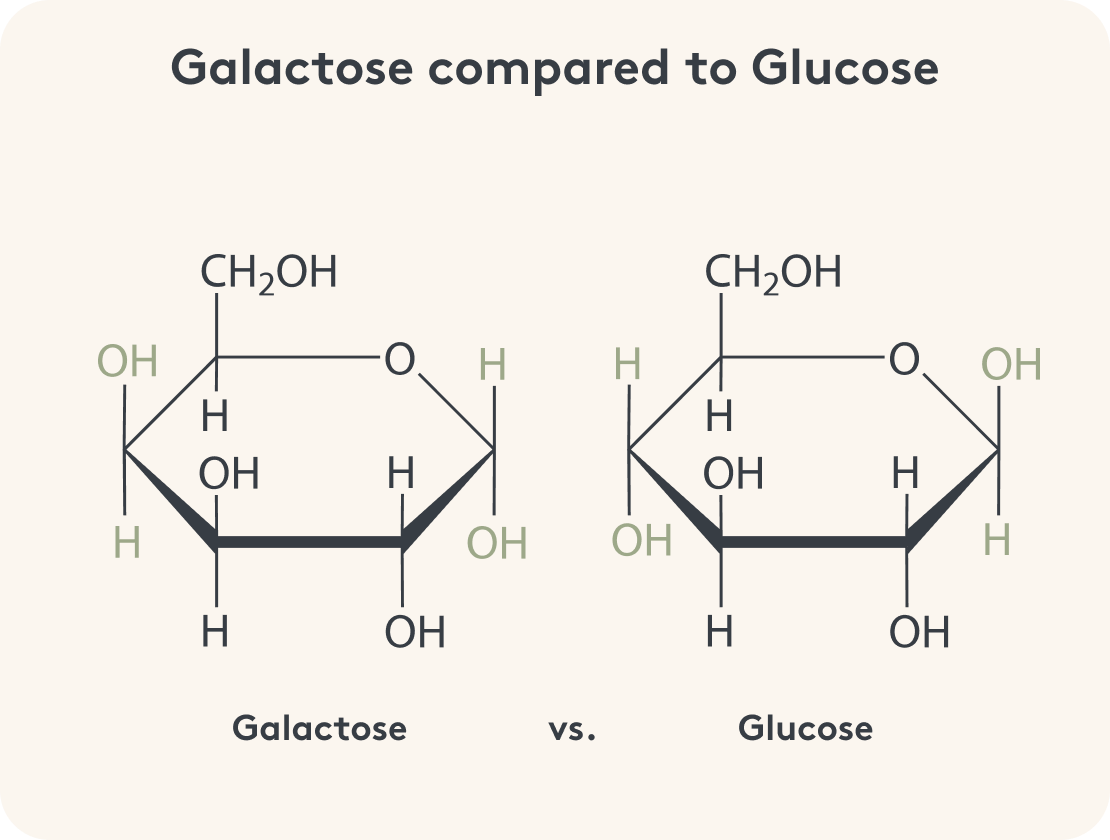

Why the combination of tagatose and galactose makes sense
The combination of galactose and tagatose provides a sugar alternative that ensures energy supply through galactose without affecting insulin levels. United with tagatose, which helps maintain tooth mineralization, as well as provides pleasant sweetness.
The right amount and the right sweeteners are important for a healthy approach to sugar
Avoiding sugar is difficult from a nutritional point of view. As you could read in this article, our body needs sugar mainly as a source of energy, but also for other processes. You can't classify sugar as bad per se, but as is often the case, the right and moderate amount is crucial. One way to limit the amount of household sugar is to replace it with other types of sugar.
Sugar and sugar substitutes in the right dosage can bring some benefits, such as providing energy, protecting teeth and reducing stress.
So it's not a matter of doing without, but of choosing wisely.
Sugar types in comparison (brief overview)
| Sweeteners | Low in calories | Naturally | Glycemic index |
|---|---|---|---|
| Table sugar | ✖ | ✔️ | ✖ |
| Sweeteners | ✔️ | ✖ | ✔️ |
| Xylitol/Erythritol | ✔️ | ✔️ | ✔️ |
| Agave syrup | ✖ | ✔️ | ✔️ |
| Honey/maple syrup | ✖ | ✔️ | partially |
| Stevia | ✔️ | ✖/✔️ | ✔️ |
| Tagatose | ✔️ | ✔️ | ✔️ |
| Galactose | ✔️ | ✔️ | ✔️ |
Sugar: Right amount & right sweeteners
The right amount and the right sweeteners are important for a healthy sugar diet. Giving up sugar is difficult from a nutritional perspective. As you've read in this article, our bodies need sugar primarily as an energy source, but also for other processes. You can't classify sugar as bad per se, but as is often the case, the right and moderate amount is crucial. One way to limit the amount of table sugar is to replace it with other types of sugar.
Sugar and sugar substitutes in the right dosage can provide several benefits, such as providing energy, protecting teeth and reducing stress.
So it’s not about doing without, but about choosing wisely.
Bibliography
- Swithers, S. E., & Davidson, T. L. (2008). A role for sweet taste: Calorie predictive relations in energy regulation by rats. Behavioral Neuroscience, 122(1), 161–173.
- Shil, A., & Chichger, H. (2021). Artificial Sweeteners Negatively Regulate Pathogenic Characteristics of Two Model Gut Bacteria, E. coli and E. faecalis. International Journal of Molecular Sciences, 22.
- Choudhary, A., Lee, Y. Y. (2018). The debate over neurotransmitter interaction in aspartame usage. Journal of Clinical Neuroscience. 56. 10.1016/j.jocn.2018.06.043.
- Uebanso, T., Kano, S., Yoshimoto, A., Naito, C., Shimohata, T., Mawatari, K., & Takahashi, A. (2017). Effects of Consuming Xylitol on Gut Microbiota and Lipid Metabolism in Mice. Nutrients, 9(7), 756.
- Mahalak, K. K., Firrman, J., Tomasula, P. M., Nuñez, A., Lee, J. J., Bittinger, K., Rinaldi, W., & Liu, L. S. (2020). Impact of Steviol Glycosides and Erythritol on the Human and Cebus apella Gut Microbiome. Journal of agricultural and food chemistry, 68(46), 13093–13101.
- Jensen, T., Abdelmalek, M. F., Sullivan, S., Nadeau, K. J., Green, M., Roncal, C., Nakagawa, T., Kuwabara, M., Sato, Y., Kang, D. H., Tolan, D. R., Sanchez-Lozada, L. G., Rosen, H. R., Lanaspa, M. A., Diehl, A. M., & Johnson, R. J. (2018). Fructose and sugar: A major mediator of non-alcoholic fatty liver disease. Journal of hepatology, 68(5), 1063–1075.
- medizin.uni-tuebingen.de/de/das-klinikum/pressemeldungen/243?press_str=. Zuletzt aufgerufen am 14.06.2022.
- Bertelsen, H. Andersen, H., Tvede, M. (2001). Fermentation of D-Tagatose by Human Intestinal Bacteria and Dairy Lactic Acid Bacteria, Microbial Ecology in Health and Disease, 13:2, 87-95, DOI: 10.1080/08910600119905
- Venema, K., Vermunt S. H. F. & Brink E. J. (2005). D-Tagatose increases butyrate production by the colonic microbiota in healthy men and women. Microbial Ecology in Health and Disease, 17(1), 47-57.
- Bridgeman, S. C., Northrop, W., Melton, P. E., Ellison, G. C., Newsholme, P., & Mamotte, C. (2020). Butyrate generated by gut microbiota and its therapeutic role in metabolic syndrome. Pharmacological research, 160, 105174.
- Imfeld, T. (1996): Telemetric evaluation of D-tagtose provided by MD Foods Ingredients Amba, Denmark, with regard to the product’s qualification as being safe for teeth“. Dental Institute, University of Zurich, Switzerland
- diabetiker.info/zuckeralternativen-auf-den-zahn-gefuehlt-was-steckt-drin-in-den-neuen-suessen/. Zuletzt aufgerufen am 16.05.2025.
- Aguer, C., Gambarotta, D., Mailloux, R. J., Moffat, C., Dent, R., McPherson, R., & Harper, M. E. (2011). Galactose enhances oxidative metabolism and reveals mitochondrial dysfunction in human primary muscle cells. PloS one, 6(12), e28536.
- Lembke, A., Pause, B. (1989). Uber die kariostatische Wirksamkeit von D(+)-Galaktose [Anticaries effectiveness of D(+)-galactose]. Zeitschrift fur Stomatologie, 86(4), 179–189.


